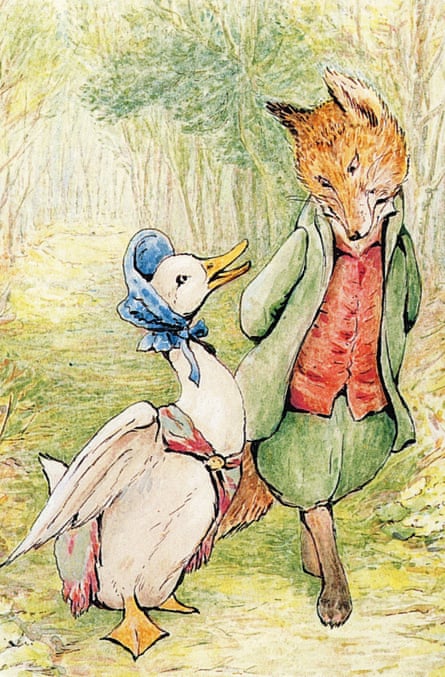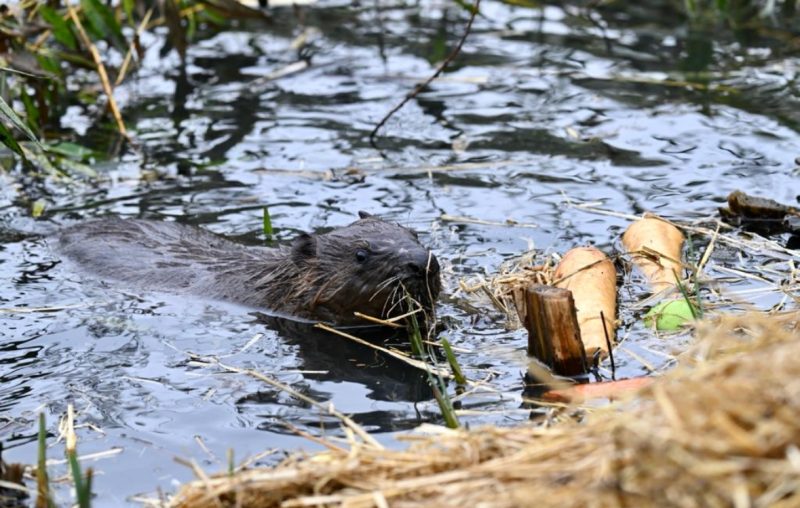The video footage that went viral last week looked like a cross between a natural history film and a documentary on the vicious nature of British politics. It showed Larry the cat, the Downing Street moggie who goes by the title of “chief mouser to the Cabinet Office”, chasing off a fox from outside the prime minister’s residence. Not Liam Fox, the former international trade secretary and Rishi Sunak supporter, but a red fox, as they are officially called – which is to say a mangy grey one.
According to research conducted by Professor Dawn Scott, executive dean for Nottingham Trent University’s School of Animal, Rural and Environmental Sciences, cats are far more likely to chase away foxes than the other way around. “Cats nearly always win,” she says.
Yet the fox remains something of an outcast in the popular imagination, characterised in children’s fiction as nasty and cunning, like the Foxy Whiskered Gentleman in Beatrix Potter’s story, who plots to cook Jemima Puddle-Duck. They’re “heavily villainised”, says Scott, and that has shaped deep-seated views of an animal often incorrectly thought of as vermin – a classification it has never received.
The brief scene of the Downing Street feline-vulpine encounter was another reminder that the urban fox has become a highly visible presence in the capital, not just in the suburbs but also in the very heart of the city.
It’s been said that this “menace”, as Boris Johnson once called urban foxes, is a kind of revenge on city-dwellers for voting to ban foxhunting. Indeed, so familiar is the sight of foxes not so much prowling as sauntering about the night-time – and even daytime – cityscape, it is now received wisdom that the urban population has exploded in recent years.
Not true, says Terry Woods, who founded Fox-a-Gon, a business for dealing humanely with fox problems. The London Wildlife Trust estimates that there are 10,000 foxes in the capital, and Woods thinks that number has been stable for several decades. “There are only 350,000 foxes in England,” he says, “and that’s the peak, when foxes are born in April. With a 60% mortality rate, that can easily drop down to 150,000.” According to Scott, foxes were first recorded in London after the second world war, and then began colonising cities around the country. By the 1980s, urban fox populations were well established.
Larry, on his home territory of Downing Street. Photograph: Tolga Akmen/EPA
However, they reach a certain density – about 10-13 per square kilometre – and then self-regulate their numbers. Although there have been cases of foxes living as long as 14 years, four out of five foxes die before they are two years old.
So why do they appear to be so numerous? Fifty years ago, anyone who said they had seen a fox on the street in London would have been accused of crying wolf. Back then, they were as rare as good restaurants.
According to Woods, they were around but better hidden and less used to human interaction, so more inclined to remain in the shadows. “They used to skulk around the ends of urban gardens,” he says, “where there was an old shed and a compost heap, and nobody really went beyond the trellis work.”
But gentrification, along with more carefully designed gardens, has left the fox with less space to hide, says Woods. “So they’re being pushed out a lot more.”
Modern city life, with its mountains of discarded takeaway food and a conspicuous absence of hunters with bugles on horseback, may seem like a fox-friendly environment but in reality it’s a constant battle. Expansive city parks offer little respite because that’s where dogs roam during the day, and foxes tend not to make their homes on dog territory. Then there’s the traffic, which accounts for a high percentage of truncated fox lives, and also illegal poisonings. Foxes are protected by wildlife laws, says the Fox-a-Gon website, “against poisoning, gassing, asphyxiation, maiming, stabbing, impaling, drowning, clubbing and most forms of snaring”.
The very existence of such a macabre list suggests the kinds of things that some would like to do to foxes, and apparently many fennecaphobes (people who fear foxes) do resort to poison.
Although foxes are extremely unlikely ever to attack ambulant humans (the only situation in which there is a small risk of a fox bite is when the animal is cornered), there have been several well-publicised reports of foxes attacking babies in cities over the past decade.
Woods won’t discuss specific cases but he is highly sceptical about the accuracy of such reports, and suggests that pet dogs are more likely to be the real culprits. But it’s not just an irrational fear of attack. Many people don’t like foxes because they’re opportunistic scavengers, unclean, and make a lot of noise having sex.
The familiar detritus of ripped-open rubbish bags attests to foxes’ scavenging habits, but Woods puts the blame for such behaviour on the residents who leave rubbish bags outside, not the foxes who hungrily tear them apart. Similarly, he notes that the mating season, usually in December or January, may be voluble but is very short.
Still, as carriers of fleas and the species of scabies known as “mange” (which afflicts one in six foxes), they are not necessarily the first mammals you’d think of cuddling up to. By and large, mange is not transmissible to humans, although there are exceptions. A couple of years ago, the former Vogue editor Alexandra Shulman contracted sarcoptes scabiei cannis after finding a fox on her sofa in her north-west London home. “I dread a fox coming near me again,” she said afterwards.
The planet’s most important stories. Get all the week’s environment news – the good, the bad and the essential
Privacy Notice: Newsletters may contain info about charities, online ads, and content funded by outside parties. For more information see our Privacy Policy. We use Google reCaptcha to protect our website and the Google Privacy Policy and Terms of Service apply.
At the other end of the spectrum, there is no shortage of city types who adore foxes, some of whom take the controversial step of feeding them. The social tensions brought about by warring Brexiters and remainers are as nothing compared with the bitter acrimony that exists between pro- and anti-fox feeders. On the social networking platform Nextdoor, the dispute is something of a bloodsport, with unrepentant fox-feeders subject to the kind of vitriol normally reserved for strangers in hoodies who spend too long tying their shoelaces.
 Beatrix Potter’s Foxy Whiskered Gentleman with Jemima Puddle-Duck. Photograph: DaisyPhotography/Alamy
Beatrix Potter’s Foxy Whiskered Gentleman with Jemima Puddle-Duck. Photograph: DaisyPhotography/Alamy
There is conflicting advice about feeding foxes, with the Chartered Institute of Environmental Health stating that “there is absolutely no reason why” the public shouldn’t feed them, before going on to warn that it might mislead foxes into believing that all humans will be friendly towards them.
“Generally, I think it’s a bad thing,” says Woods. “It’s a bad thing for the foxes. It’s a good thing for the people that are doing it, because it quite often gives them a purpose in life.”
Scott notes that many people feed foxes the wrong sorts of foods – leftovers rich in fats and carbohydrates – and in the wrong way – by hand or from the back door. In any case, research suggest that vulpine dependence on humans makes foxes lazy.
There is also some evidence to suggest that urban foxes are beginning to differ physiologically from their country cousins, with one study showing that they have shorter snouts, smaller brain cases and reduced sexual dimorphism (the physical difference between a dog fox and vixen).
If these distinctions become more apparent, it will doubtless add to the misconception that country foxes are “natural” and the city version some kind of malign aberration.
The truth is, however, that as the most widespread wild carnivore on the planet (which must account for its recurrence in folklore), the fox doesn’t have a natural habitat. Like humans, they live wherever they can.
Instead of demonising them, says Scott, we should remember that we have already lost so many animals in the wild and then “take a step back and see that foxes are an amazing, beautiful wildlife that we’re lucky to be able to see”.
Forget the urban myths and behold the urban fox!
https://www.theguardian.com/environment/2022/oct/15/urban-foxes-are-they-fantastic-or-a-growing-menace





